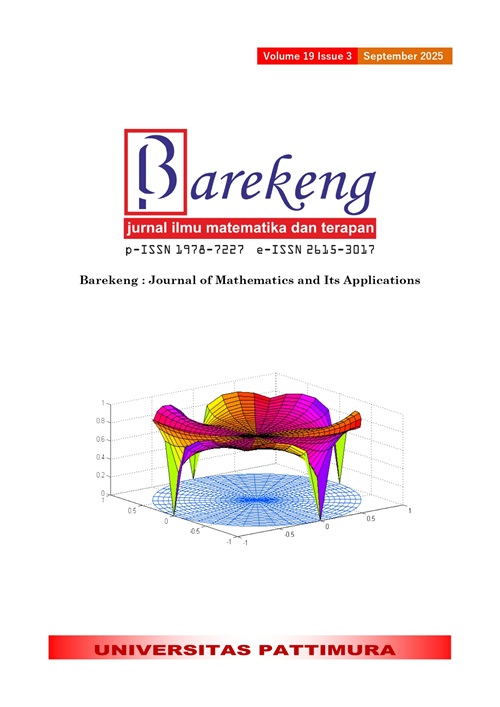MODELING THE IDX30 STOCK INDEX USING STEP FUNCTION INTERVENTION ANALYSIS
Abstract
The significant decline in the IDX30 stock index occurred due to an intervention, namely the COVID-19 pandemic, which affected market stability and investment decisions. This study aims to model and forecast the IDX30 stock index using intervention analysis with a step function, which is very suitable for capturing long-term external shocks. The methodology used includes the ARIMA (AutoRegressive Integrated Moving Average) model combined with step function intervention analysis to account for structural changes due to external disturbances. The data used is sourced from investing.com, consisting of weekly IDX30 stock index prices from January 2019 to December 2023. The results show that the COVID-19 pandemic significantly impacted the IDX30 index, causing a drastic decline. The best model identified is ARIMA (1,2,1) with intervention parameters b = 0, s = 0, and r = 1. The forecasting results range from Rp. 488 to Rp. 505, with a Mean Absolute Percentage Error (MAPE) of 1.9404%, which shows the forecasting results are very good, indicating high forecasting accuracy. These findings highlight the effectiveness of intervention analysis in modeling financial time series data affected by external disturbances.
Downloads
References
V. Hartantio and Yusbardini, “PENGARUH BERBAGAI INDEKS SAHAM ASIA TERHADAP INDEKS HARGA SAHAM GABUNGAN TAHUN 2015-2019,” Jurnal Manajerial dan Kewirausahaan, vol. 2, no. 4, pp. 1096–1105, 2020.doi: https://doi.org/10.24912/jmk.v2i4.9895
A. Rizali, “EKSISTENSI DAN STRATEGI PENGEMBANGAN SAHAM SYARIAH DI MASA PANDEMI COVID-19,” Jurnal Ekonomi Islam, vol. 13, 2020.doi: https://doi.org/10.26623/jreb.v13i2.2434
E. Purnaningrum and V. Ariyanti, “PEMANFAATAN GOOGLE TRENDS UNTUK MENGETAHUI INTERVENSI PANDEMI COVID-19 TERHADAP PASAR SAHAM DI INDONESIA,” Jurnal Majalah Ekonomi, vol. 25, no. 1, pp. 1411–9501, 2020.doi: https://doi.org/10.36456/majeko.vol25.no1.a2520
I. Wahidah et al., “PANDEMIK COVID-19: ANALISIS PERENCANAAN PEMERINTAH DAN MASYARAKAT DALAM BERBAGAI UPAYA PENCEGAHAN COVID-19 PANDEMIC: ANALYSIS OF GOVERNMENT AND COMMUNITY PLANNING IN VARIOUS PREVENTION MEASURES,” Jurnal Manajemen dan Organisasi (JMO), vol. 11, no. 3, pp. 179–188, 2020.doi: https://doi.org/10.29244/jmo.v11i3.31695
M. A. Hadi and Z. Arifin, “RESPON PASAR MODAL TERHADAP PERISTIWA COVID-19 (STUDI PADA INDEKS SAHAM IDX-30 DI BURSA EFEK INDONESIA),” Indonesian Journal of Economics, vol. 1, no. 8, 2024.
S. A. Zukrianto, W. Rahayu, and D. Siregar, “PERAMALAN INDEKS SAHAM LQ45 PADA MASA PANDEMI COVID-19 MENGGUNAKAN ANALISIS INTERVENSI,” Jurnal Statistika dan Aplikasinya, vol. 5, no. 2, pp. 251–259, 2021.doi: https://doi.org/10.21009/JSA.05213
A. F. Sustrisno, Rais, and I. Setiawan, “INTERVENTION MODEL ANALYSIS THE NUMBER OF DOMESTIC PASSENGERS AT SULTAN HASANUDDIN AIRPORTS,” Journal of Statistics, vol. 1, no. 1, pp. 41–49, 2021.doi: https://doi.org/10.22487/27765660.2021.v1.i1.15436
F. Rianda and H. Usman, “FORECASTING TOURISM DEMAND DURING THE COVID-19 PANDEMIC: ARIMAX AND INTERVENTION MODELLING APPROACHES,” BAREKENG: Jurnal Ilmu Matematika dan Terapan, vol. 17, no. 1, pp. 0285–0294, Apr. 2023, doi: https://doi.org/10.30598/barekengvol17iss1pp0285-0294.
R. W. Maharsi and N. A. N. Roosyidah, “ANALISIS PERBANDINGAN KEBAIKAN MODEL INTERVENSI FUNGSI STEP DAN ARIMA BOX JENKINS,” Jurnal Ilmiah Komputasi dan Statistika, vol. 1, no. 2, pp. 1–10, 2022.
B. Diharjo and R. Arief, “PREDIKSI HARGA SAHAM INDEKS IDX30 DI INDONESIA SAAT PANDEMI COVID-19 DENGAN AUTOREGRESSIVE INTEGRATED MOVING AVERAGE (ARIMA),” Jurnal Ilmiah Informatika Komputer, vol. 26, no. 3, pp. 248–276, 2022.doi: https://doi.org/10.35760/ik.2021.v26i3.5029
P. Hlaváčková, J. Banaś, and K. Utnik-Banaś, “INTERVENTION ANALYSIS OF COVID-19 PANDEMIC IMPACT ON TIMBER PRICE IN SELECTED MARKETS,” For Policy Econ, vol. 159, Feb. 2024, doi: https://doi.org/10.1016/j.forpol.2023.103123.
G. E. P. Box, G. M. Jenkins, G. C. Reinsel, and G. M. Ljung, “TIME SERIES ANALYSIS: FORECASTING AND CONTROL: Fifth Edition, New Jersey: John Wiley & Sons,” J Time Ser Anal, 2016.
D. Siregar, “PERBANDINGAN PEMODELAN DAN PERAMALAN HARGA GULA BERDASARKAN MODEL SPACE TIME ARIMA DAN GENERALIZED SPACE TIME ARIMA,” Institut Pertanian Bogor, Bogor, 2015.
A. P. Wulansari, B. Sutijo, S. Ulama, and M. Si, “STOCK PRICE FORECASTING OF GOLD MINING COMPANIES IN INDONESIA USING UNIVARIATE AND MULTIVARIATE TIME SERIES UNDERGRADUATE PROGRAMME DEPARTMENT OF STATISTICS FACULTY OF MATHEMATICS AND NATURAL SCIENCES INSTITUT TEKNOLOGI SEPULUH NOPEMBER SURABAYA 2016.” [Online]. Available: http://finance.yahoo.com/.
H. Panjaitan, A. Prahutama, D. Statistika, and F. Sains dan Matematika, “PERAMALAN JUMLAH PENUMPANG KERETA API MENGGUNAKAN METODE ARIMA, INTERVENSI DAN ARFIMA (Studi Kasus: Penumpang Kereta Api Kelas Lokal EkonomiDAOP IV Semarang),” vol. 7, no. 1, pp. 96–109, 2018, [Online]. Available: https://ejournal3.undip.ac.id/index.php/gaussian/
R. Ekayanti, N. Mara, and E. Sulistianingsih, “ANALISIS MODEL INTERVENSI FUNGSI STEP UNTUK PERAMALAN KENAIKAN TARIF DASAR LISTRIK (TDL) TERHADAP BESARNYA PEMAKAIAN LISTRIK,” 2014.
A. Iswari, “PERBANDINGAN MODEL SARIMA DAN INTERVENSI DALAM PERAMALAN JUMLAH PENUMPANG DOMESTIK DI BANDARA INTERNASIONAL SOEKARNO-HATTA,” Institut Pertanian Bogor, Bogor, 2021.
A. Krisma, M. Azhari, and P. P. Widagdo, “PERBANDINGAN METODE DOUBLE EXPONENTIAL SMOOTHING DAN TRIPLE EXPONENTIAL SMOOTHING DALAM PARAMETER TINGKAT ERROR MEAN ABSOLUTE PERCENTAGE ERROR (MAPE) DAN MEANS ABSOLUTE DEVIATION (MAD),” Prosiding Seminar Nasional Ilmu Komputer dan Teknologi Informasi, vol. 4, no. 2, pp. 81–87, 2019.
W. A. Pradani, A. Setiawan, and H. A. Parhusip, “ANALISIS REGRESI NONLINEAR PADA DATA PASIEN COVID-19 MENGGUNAKAN METODE BOOTSRAP,” BAREKENG: Jurnal Ilmu Matematika dan Terapan, vol. 15, no. 3, pp. 453–466, Sep. 2021, doi: https://doi.org/10.30598/barekengvol15iss3pp453-466.
Copyright (c) 2025 Rais Rais, Dini Aprilia Afriza, Iman Setiawan, Hartayuni Sain, Fadjryani Fadjryani, Junaidi Junaidi

This work is licensed under a Creative Commons Attribution-ShareAlike 4.0 International License.
Authors who publish with this Journal agree to the following terms:
- Author retain copyright and grant the journal right of first publication with the work simultaneously licensed under a creative commons attribution license that allow others to share the work within an acknowledgement of the work’s authorship and initial publication of this journal.
- Authors are able to enter into separate, additional contractual arrangement for the non-exclusive distribution of the journal’s published version of the work (e.g. acknowledgement of its initial publication in this journal).
- Authors are permitted and encouraged to post their work online (e.g. in institutional repositories or on their websites) prior to and during the submission process, as it can lead to productive exchanges, as well as earlier and greater citation of published works.






1.gif)



